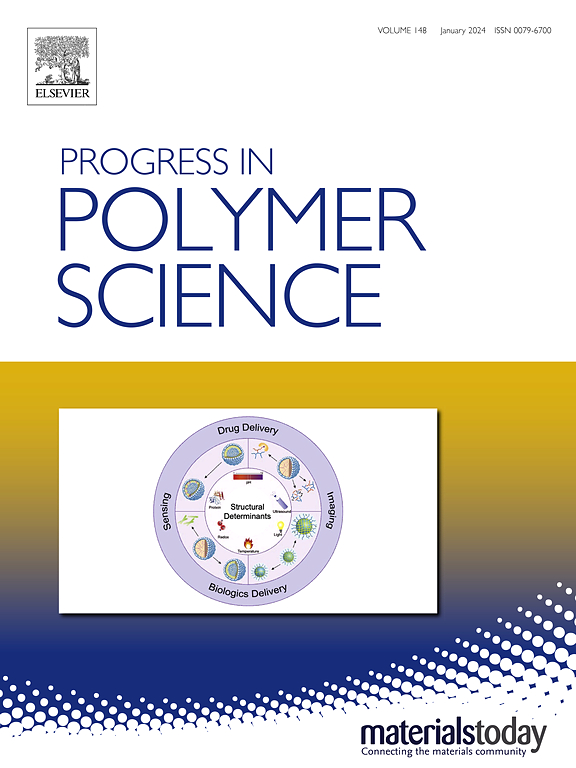Recent advances in the design of hydrogels: Renaissance of the Hofmeister effect
IF 26.1
1区 化学
Q1 POLYMER SCIENCE
引用次数: 0
Abstract
The Hofmeister effect has been known for >135 years since Hofmeister and Lewith’s foundational work. Over the past decade, salt treatment induced by the Hofmeister effect in concentrated gelator molecules has attracted considerable interest in designing functional hydrogels without any complicated chemical modifications. Herein, we provide a detailed overview of recent advances in using the Hofmeister effect to regulate the properties of hydrogels, from the perspective of fundamental theories to applications. This review comprehensively emphasizes the main interactions or effects related to specific ions influencing the performance of pre-gel solutions for hydrogel formation. Moreover, this review focuses on the roles of salt ions in regulating the properties and functionalities of hydrogels, including mechanical properties, ionic conductivity, anti-freezing capability, optical properties, printability, analytical sensitivity, and shape memory ability. Additionally, we provide an overview of the potential applications of these hydrogels in various fields. Finally, this review highlights the challenges and opportunities of this approach and proposes potential issues for understanding the Hofmeister effect in designing functional hydrogels. The broad scale and versatility of this approach make it a promising strategy for developing task-specific hydrogels with customized properties and functionalities.


水凝胶设计的最新进展:霍夫迈斯特效应的复兴
自从霍夫迈斯特和利维斯的基础工作以来,霍夫迈斯特效应已经被人们知道了135年。在过去的十年中,浓缩凝胶分子中由Hofmeister效应引起的盐处理引起了人们对设计不需要任何复杂化学修饰的功能水凝胶的极大兴趣。本文从基础理论到应用的角度,详细综述了利用霍夫迈斯特效应调节水凝胶性质的最新进展。本文综述了影响水凝胶形成的预凝胶溶液性能的主要相互作用或与特定离子相关的效应。此外,本文还对盐离子在水凝胶的力学性能、离子电导率、抗冻性、光学性能、可打印性、分析灵敏度和形状记忆能力等方面的调控作用进行了综述。此外,我们还概述了这些水凝胶在各个领域的潜在应用。最后,本综述强调了该方法的挑战和机遇,并提出了在设计功能水凝胶时理解霍夫迈斯特效应的潜在问题。这种方法的广泛规模和多功能性使其成为开发具有定制属性和功能的特定任务水凝胶的有前途的策略。
本文章由计算机程序翻译,如有差异,请以英文原文为准。
求助全文
约1分钟内获得全文
求助全文
来源期刊

Progress in Polymer Science
化学-高分子科学
CiteScore
48.70
自引率
1.10%
发文量
54
审稿时长
38 days
期刊介绍:
Progress in Polymer Science is a journal that publishes state-of-the-art overview articles in the field of polymer science and engineering. These articles are written by internationally recognized authorities in the discipline, making it a valuable resource for staying up-to-date with the latest developments in this rapidly growing field.
The journal serves as a link between original articles, innovations published in patents, and the most current knowledge of technology. It covers a wide range of topics within the traditional fields of polymer science, including chemistry, physics, and engineering involving polymers. Additionally, it explores interdisciplinary developing fields such as functional and specialty polymers, biomaterials, polymers in drug delivery, polymers in electronic applications, composites, conducting polymers, liquid crystalline materials, and the interphases between polymers and ceramics. The journal also highlights new fabrication techniques that are making significant contributions to the field.
The subject areas covered by Progress in Polymer Science include biomaterials, materials chemistry, organic chemistry, polymers and plastics, surfaces, coatings and films, and nanotechnology. The journal is indexed and abstracted in various databases, including Materials Science Citation Index, Chemical Abstracts, Engineering Index, Current Contents, FIZ Karlsruhe, Scopus, and INSPEC.
 求助内容:
求助内容: 应助结果提醒方式:
应助结果提醒方式:


